
Atlas F1 Senior Writer
The teams may hate going to the balmy, bumpy, ill-equipped Interlagos circuit, a track where advertising hoardings have fallen on drivers and team members have been held up at gunpoint. But more often than not the winner of the race goes on to become the World Champion. Thomas O'Keefe looks back at the history of the circuit and reflects on the events that define it
FIA president Max Mosley conceded as much when he said "Well, everybody says it's not very good. I have to confess that the last time I went to Brazil was in '82 and that was Rio so I can't claim to be up-to-date. The biggest problem is that we don't have another South American race. We're a little bit in difficulty that if we cancelled Brazil, that's it, that's South America right off the World Championship calendar which is a great traditional place, so there's a reluctance.
"But a point is coming where if they don't do something, that's it. It is a reason for keeping a race. So if people don't want to take is seriously ... You have to weigh up how much we are willing to tolerate Interlagos versus the importance of having at least one event in South America. If South America went, it would probably have an effect on the whole of South America in a way. Things change. Suddenly there's Montoya coming up. We're always saying we want to be more of a World Championship."
Brazil remains on the calendar not just as Formula One's version of Affirmative Action, but because it deserves to be there for the consistently interesting races the Brazilian race produces and because of the combination of the track itself and the place the Brazilian Grand Prix occupies on the calendar as the last of the flyaway races before the teams head "home" to Europe.
Although we have become accustomed to the strength in numbers represented by the Brazilian contingent in Formula One and in the other open-wheel formulas from Ayrton Senna to Cristiano da Matta, it was not always this way and really goes back to the career of Emerson Fittipaldi, with whom the Interlagos circuit is inextricably connected. Thirty years later, Fittipaldi is still in open-wheel racing, now as a new team owner in the American Champ Car series.
In terms of longevity, the modern Argentinean Grand Prix began in 1972 and the Swedish Grand Prix began in 1973 (along with Brazil); both are long gone while Brazil lives on. From the outset, the racing has justified the enthusiasm of the crowds there.
By 1972, Fittipaldi had been in Formula One for two seasons and had already demonstrated the quality of the Brazilian drivers to come. Fittipaldi participated in the first non-championship Formula One race that was held at Interlagos and the traditions that still prevail at the Brazilian Grand Prix took hold: huge and enthusiastic crowds of Brazilians and European emigres cheering their heroes in the searing heat, relieved from sunstroke by track marshals occasionally hosing down the sun-drenched crowd with the hoses usually deployed as track safety equipment. Argentinian Carlos Reutemann took the win in his Brabham BT34, but Fittipaldi's black and gold liveried Lotus 72 had pole position, set fastest lap and led the race until the suspension of the Lotus failed him on lap 32 of the 37 lap race.
At the official inaugural 1973 Brazilian Grand Prix at Interlagos Fittipaldi turned upside down the results of the 1972 race, set fastest lap and led the race from the first corner to the checkered flag 40 laps later, still in the long-lived Lotus 72. There were tens of thousands of people in the long line of grandstands along the front straight that day to watch Colin Chapman throw his black John Player Lotus cap in the air as Fittipaldi streaked across the finish line.
By the time of the second Brazilian Grand Prix Fittipaldi had left Lotus and was driving the red and white Marlboro/Texaco McLaren M23-Ford but he again qualified on pole in a race that was to inaugurate another Brazilian Grand Prix tradition: rain. Carlos Reutemann, now driving the Gordon Murray-designed white and blue pin-striped Brabham BT 44 owned by Bernie Ecclestone, had dominated (but then lost) the Grand Prix of Argentina in Buenos Aires. Reutemann's Brabham again ran up front in the opening laps of the Brazilian Grand Prix but he used up his Goodyear's too fast and yielded the lead first to the Lotus of Ronnie Peterson and then to Fittipaldi's McLaren, who then led until lap 32 when the race was stopped some 8 laps early due to heavy rain. Fittipaldi's win established another tradition. It would turn out that a high percentage of World Champions won the Brazilian Grand Prix early in what would become their Championship season, as did Fittipaldi in 1974.
In 1975 Fittipaldi returned to Interlagos in the McLaren M23 as a two-time World Champion but was upstaged by Carlos Pace, the latest emerging Paulista talent who was now driving the Brabham BT44B, the prettiest evolution of the Murray design, under Martini Racing colors. Pace, whose racing career was tragically cut short in 1977 by his death in a plane crash, won his only race that day at Interlagos, finishing just over five seconds ahead of his compatriot Fittipaldi, besting not only his highly-rated Brabham teammate Reutemann but also Jean-Pierre Jarier, whose UOP Shadow DN5 had been on pole and had led most of the race before problems developed with his fuel injection system. Today, the formal name of the Interlagos circuit is "Autodrome Jose Carlos Pace", in his honor.
In 1976, the first non-Brazilian, Niki Lauda, convincingly won the Brazilian Grand Prix by leading laps 9-40 in the year that Lauda's Ferrari 312T lost the World Championship to James Hunt's McLaren M23-Ford by one point. It was also Ferrari's first victory at Interlagos. By this time, the bloom was off the Brazilian rose since Emerson Fittipaldi had joined his brother Wilson's eponymous Copersucar-Fittipaldi team. Brazilians Ingo Hoffman and Emerson Fittipaldi finished 11th and 13th respectively. Carlos Pace did better, finishing 10th in the Brabham BT45 Alfa Romeo.
In 1977, Ferrari won again, this time with Carlos Reutemann driving the 312T2 with a special wing (given to Reutemann but not Lauda, a slight that did not go unnoticed by Niki) and finally Reutemann won at a track where he had always qualified and run well. Carlos Pace upheld the honor of Brazil by leading the 1977 Brazilian Grand Prix in the Brabham BT45 - Alfa Romeo for the first six laps but he ultimately retired because of an accident on lap 33 of the 40 lap race. In less than two months Pace would be dead.
In 1979 and 1980, Interlagos was reinstated as the venue for the Brazilian Grand Prix and both races turned out to be very much departures from the norm: in 1979, Jacques Laffite had a perfect race in his Ligier JS11-Ford: pole position, fastest lap, won the race and was in the lead flag to flag. To round out this stunning triumph, Laffite's teammate Patrick Depailler, finished in second place. In 1980, Rene Arnoux in the Renault RE20 turbo won the Brazilian Grand Prix in what would be Arnoux's first Grand Prix win as well as the last Brazilian Grand Prix to be held at Interlagos until 1990. It was another all French d'affaire: Jean-Pierre Jabouille, Arnoux's Renault teammate, took pole and led for 22 laps until the Renault turbo let go, French-Canadian Gilles Villeneuve also led, and Arnoux got fastest lap, and led the last 15 laps of the race after Jabouille went out.
From 1981-1989, the Brazilian Grand Prix permanently relocated to Rio, where French luck continued, with Alain Prost winning for Renault in 1982 (after successfully protesting the Brabham and Williams cars) and again for McLaren in 1984, 1985, 1987 and 1988. The newest Brazilian hotshoe, Nelson Piquet, won in 1982 in the Brabham-BMW BT52 (the rakish-looking white and blue Parmalat Brabham) and again in 1986 in the Williams FW11-Honda. After a drought going back to Reutemann's win for Ferrari in 1978, Nigel Mansell won at Rio in 1989, driving the Ferrari 640.
Ayrton Senna had been racing in Formula One since 1984, had been crowned World Champion in 1988 and yet could not manage to win a Brazilian Grand Prix despite many gallant efforts. In 1984 Senna finished dead last in his Toleman-Hart after going out on lap 8 with a turbo problem in his very first Grand Prix. In 1985 he qualified in fourth place in his Lotus-Renault but went out with electrical problems. In 1986 he was on pole in his Lotus-Renault but placed second to Nelson Piquet. In 1987 he qualified in third place but went out with engine problems with eleven laps to go. In 1988, his Championship year, he qualified on pole and made an astonishing comeback after switching to his spare McLaren-Honda after the parade lap and starting from the pit lane. But it was all for nought when he was disqualified by the Stewards for making the last minute switch after 31 laps and having clawed his way back to second place. In 1989 he found yet another way to ruin a Brazilian Grand Prix, tangling with Berger's Ferrari in the very first turn, spoiling another chance for a victory.
But in 1990, it was a new decade, a new track and a new Senna. The original 4.95 mile Interlagos circuit included a sweeping outer section, challenging elevation changes and massive grandstands on the main straight that gave the fans the best possible views of the long arching high speed left-hander that led onto the main straight, the straight itself and the first turn. The new version of Interlagos was shortened to 2.6 miles, the fast outer section was history but the essential character of the plunging topography and the dramatic front straight as well as the corners leading to it and from it were preserved. The circuit was still bumpy.
But although Senna qualified on pole for the 1990 race, arch-rival Prost in the Ferrari 641 won the race and Senna ended up third behind Gerhard Berger, his new teammate driving the McLaren-Honda MP4, but not without drama. Senna had dominated the 1990 race but as he was lapping his ex-Lotus teammate Satoru Nakajima, now in a Tyrrell-Ford, Nakajima misjudged the situation and drove across Senna's bow, crumpling his front wing assembly, which required a pitstop.
In the 1991 race, it finally all came good for Senna. He had just won the U.S. Grand Prix at Phoenix, leading all 81 laps, and did the same thing at Interlagos, despite losing gears and ended up with only sixth gear in the closing laps as the rains came, leaving him slithering around a wet Interlagos in difficult circumstances. After eight years of trying to win a Brazilian Grand Prix Senna had finally done it, but he was spent and sat exhausted in the cockpit in parc ferme, helmet off. Nonetheless, for himself and the fans he gathered himself up and mounted the podium with the Brazilian flag in hand to accept the accolades of his fellow countryman.
In 1992, it was the year of the world-beating Williams-Renault FW14B driven by Nigel Mansell to his World Championship, and Brazil fell to Mansell as did another eight Grands Prix that season. It is notable that then-newcomer Michael Schumacher finished third in this 1992 race, his first Brazilian Grand Prix, a race in which Schumacher nearly always shows well. Senna had retired after 18 laps with electrical problems.
Senna ran in his last Brazilian Grand Prix on March 27, 1994; he would die barely a month later. And almost as if they were being drawn together by magnetic attraction, Schumacher and Senna squared off again at Interlagos for the last time. Senna was on pole; Schumacher set fastest lap. Senna led for the first 20 laps and then Schumacher led from lap 23 to 71 and won the race. Senna spun off the track and out of the race while chasing Schumacher up the fast lefthander that leads to the main straight. Schumacher clinched this first race of the season and never looked back, winning his first World Championship in 1994.
In 1995 the Brazilian Grand Prix was again the first race on the calendar and Schumacher in his Benetton-Renault won it, with David Coulthard's Williams-Renault in second place and Berger third in a Ferrari. Once again the winner at Brazil was to end up World Champion for the year 1995. In 1996 Schumacher reverted to taking third place at Interlagos, with the victory going to Damon Hill's Williams-Renault; as with Schumacher previously, Hill would ultimately win the 1996 World Championship in a year in which he got off to a good start by winning the Brazilian Grand Prix. In 1997, the pattern persisted, as Jacques Villeneuve in the Williams-Renault was on pole, set fastest lap and won the race at Interlagos in his Championship year.
In 1998, the Silver Arrows were reborn and Mika Hakkinen was on pole at Interlagos in his McLaren-Mercedes MP4/13, set fastest lap and led all 72 laps, finishing ahead of teammate Coulthard in second place. Hakkinen went on to take his first World Drivers' Championship, and Schumacher occupied his usual third position. In 1999, Hakkinen almost duplicated his dominating performance of the prior year in winning in Brazil, taking pole and setting fastest lap; he let Schumacher lead for about 10 laps before consigning the Ferrari to second place. Again, it was a Championship year for Hakkinen.
In 2000, Michael Schumacher won the Brazilian Grand Prix for the third time and, as he had done in 1994 and 1995, went on to win the World Drivers' Championship that year. But importantly, the 2000 race displayed the passing opportunities that even the shortened version of Interlagos continues to present. Since 1990 drivers have figured out that the long and fast run-up to the front straight positions the cars for the most likely overtaking point at the end of the straight just as the road turns left, off camber, then right, and plunges down. In 1990, Thierry Boutsen in his Williams-Renault passed Berger's McLaren-Honda on lap 8 by outbraking him into the first corner at the end of the front straight. Alain Prost, on his way to winning the race, repeated the move on Berger on lap 18, pulling out of the McLaren's draft and moving out ahead into Turn 1.
In the 2000 race, the Boutsen/Prost passes of ten years earlier were duplicated and improved upon in breathtaking parallel passes by the Ferrari team in the opening laps, Schumacher taking Hakkinen at the end of the straight just before Turn 1 and Barrichello overtaking Coulthard at the other end of the main straight, the fast lefthander that feeds the cars onto the front straight. The 2000 race is also remembered for the penalty imposed on David Coulthard by the Stewards - disqualification - for a drooping front wing that had been loosened by the battering the McLaren took on the bumpy circuit. The Stewards concluded that the front wing was out of compliance with the height requirement by the end of the race, costing Coulthard a hard-earned second place.
Restarts are right up Juan Pablo Montoya's alley, since rolling restarts in Indycar racing are the bread and butter of the sport, and as the field gathered itself up to restart down the long straight Montoya put the BMW horsepower to work, built up momentum and just after the start/finish line swooped right by Schumacher on the inside, himself is a master of restarts. Adding insolence to injury, Montoya held his line and his slight advantage as the two cars braked and turned down into Turn 1 and continued to crowd Schumacher, touching wheels and forcing the Ferrari off into the dirt, as Montoya edged past. Although Schumacher recovered he discovered that day that there was at least one other driver out there with the kind of mental toughness in race situations that he thought he had a monopoly on.
When Schumacher was asked about the pass in the post-race press conference he minimized the brilliance of Montoya's bold move, attributing it to a variety of factors having nothing to do with Montoya's talent: "It was pretty easy, I mean he had quite a lot of straight-line speed in comparison to us. The problem here is that it's a very long straight from the last corner to the start finish line so you have to give a long time for the Safety Car to go off then before you can start to push and you only have until this last corner. And the guys are very close to you from there and it is very easy then to take the slipstream and go past into the first corner. Although I thought I was in front enough to keep in front, I mean he must have braked very late and he just got it right. I mean he pushed me wide on the exit, which is pretty normal racing, we touched a bit but no problem with that and then I thought I could have a run at him at a later stage but I never got really in that position." The pass took place in April 2001; by late September 2001, Schumacher was becoming more generous in his praise of Montoya's methods, crediting Montoya's lunge at him in the opening laps of the U.S. Grand Prix at Indy: "where did he come from," asked the wide-eyed Schumi.
In last year's race there were some interesting pyrotechnics before the race itself, featuring Bernoldi's Arrows bursting into flames at Turn 1 during warm-up, with Alex Ribeiro coming to his rescue in the medical car. Nick Heidfeld - who did not see the accident because he was in the first part of the curve - attempted to thread the needle between the medical car and the inner barrier of the track, instead ending up wiping out the driver's door when Ribeiro opened it at just the wrong moment.
When the race itself got underway, there was a truncated reprise of the Schumacher/Montoya 2001 show. Remember that at this point in the 2002 season, Schumacher was only 2 points ahead of Montoya, and Montoya had been given a stop-and-go penalty in Malaysia for a first corner accident which happened when Montoya squeezed Schumacher (who was on pole) to the inside and, with neither driver yielding, the Ferrari understeered into the Williams and Schumacher lost his front wing in the process. Prior to the incident, Schumacher had performed the patented "Schuey Chop" and crossed the track to get to the inside of Montoya. The FIA's stewards said the Schumacher/Montoya accident was avoidable and blamed Montoya, which practically no one else did (even Schumacher more or less exonerated Montoya), for what would be called "a racin' deal" in NASCAR. When Montoya reversed the tables and qualified on pole in Brazil with Schumacher next to him it is possible that the Columbian thought he had a few credits due from the FIA stewards in Brazil.
Interlagos runs counterclockwise and although not on pole Schumacher was lined up on the inside of the track with Montoya on the outside as the front now took off down the hill toward the Senna S Curve. Montoya got off the line quickest and began to do his version of the Schuey Chop, but it was a poor imitation and the red nose of Schumacher's Ferrari continued to occupy the spot where Montoya was heading. With the chop having failed Schumacher had a good line as they turned left into the first part of the S curve, Schumacher uncharacteristically lighting up the Bridgestones as he left his braking late, usually a Montoya trademark. As the two cars entered the apex of the turn where Montoya had been the aggressor in 2001 it was Schumacher who gained ground, as Montoya's Michelin tires gave up their grip, he ran wide and slid on his own over the green and yellow kerbing, losing precious split seconds correcting his mistake as Schumacher pulled even with him and they were wheel-to-wheel.
As the two cars emerged from the other end of the S curve, headed for the first short straight en route to the Curva de Sol, Montoya had recovered his bearings and was right under the rear wing of the Ferrari, impatient to get by. As Michael straightened up after the turn and the two cars passed the 200 meter braking marker, it all turned ugly for Montoya. The dueling duo were on the far right hand side of the track after exiting the S Curve, with plenty of room to pass on the left if the BMW horsepower was up to it. The Columbian shadowed Schumacher's every jink and jive and once they were both on the left side of the track he went for a pass around the right side of the Ferrari which, unfortunately, ended in tears as Michael changed direction to the right just as Montoya was about to pass and Montoya's front wing was blasted into smithereens as the Williams touched the left rear wheel of the Ferrari 2002 as Montoya was about to try the pass; the left front tire of the Williams was also punctured in the accident when Montoya ran over his own debris. Montoya returned to the pits for a new nose and front wing assembly which cost him 19 seconds, an errant Union Jack kite bizarrely caught to the rear wing as he limped back to the pits. The rear tires and suspension of Schumacher's brand new Ferrari F2002 held up and he continued in the lead.
All of which sets us up for a fascinating Interlagos race this year which, as in past years could prove to be a divining rod of who will win the World Championship. Unlike recent years, the McLaren team has won both of the opening races and Michael Schumacher has not won any of the flyaway races; even the usually taciturn brother Ralf Schumacher has said he believes BMW-Williams can take it to the Scuderia and in the 2002 race he lost to his brother by only a whisker after dogging him throughout the closing days.
Barrichello, like Senna before him, has tried and failed now ten times to win his home race and surely must be due for a change of luck for possibly his last best chance to win the Big One, provided the HANS device holds up for him. His teammate, having won four times and always finished in the points, is possibly due for another off day in the 2002-spec car, if there is justice in racing.
Coulthard has been strong so far this year and has often run well at Interlagos, and fondly remembers his own pass on Michael in 2001 slipstreaming down the straight, both cars engulfing the Minardi of Tarso Marques, with Coulthard making the more committed move and getting by Schumacher. Notice how Schumacher described Coulthard's move, again minimizing it and giving David short shrift, as he did Montoya: "Initially I mean, the Minardi was completely on the left side so, I was [hoping he'd] stay there, and I could dive through the outside. I knew David was on my left somewhere but when I came to the braking point you know he started to [go] over to the right and I didn't know how far away and whether I would be safe or not. So I had to slow down more than I needed and obviously David took the right choice to the inside, but when I had decided what I was going to do, because I was closer to the Minardi, there was only the outside available to me, honestly. But to be honest you have seen the race and he would have catched me later at some stage." But at least for once, no complaints from Coulthard as to the Minardi's holding up his McLaren. So Coulthard is ready to win again in Brazil in 2003 and, given Raikkonen's maiden win in Malaysia, is now challenged all the more, intra-team.
But Montoya is also ready, and he may have a better car for the long straight at Interlagos. It should not be forgotten that Montoya went on in 2001 after the pass to lead convincingly until Jos Verstappen punted him off on lap 39, and the 2002 incident with Schumacher at Curva de Sol robbed him of any chance to repeat the success of his rookie year at Interlagos. Now older and wiser, the Colombian would clearly love to be the Other South American - the Reutemann of his era - and win the race that seems to get his juices flowing more than most.
And so on to the 21st edition of the Grand Prix of Brazil at Interlagos, with its rich history of racing and racers, its distinctive and patriotic green and yellow kerbings, its dramatic elevation changes, the hidden brows, the adverse camber turns, the bumpiness, and, in a word, the tradition, of one of the great old tracks of Formula One where it is almost always the case that only World Champions win.
The Interlagos track is bumpy and for all the good intentions of the feisty and charismatic Marta Suplicy, Mayor of Sao Paulo, her city is not in a position to fund the kind of major reconstruction project that would bring both the track and the facility up to the state of the art standards of Malaysia or Indianapolis. Teams have had their computer equipment stolen from them in the dark of night and have had cash taken from them at gunpoint in broad daylight. Advertising hoardings have been known to come unhinged at inopportune times, endangering fans and drivers; one year, an overhead steel gantry and TV camera suddenly collapsed in the Jaguar pit, almost ending Bobby Rahal's days at Jaguar before Niki Lauda did!
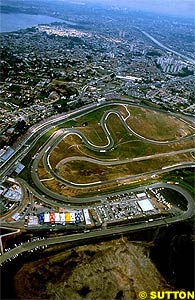 Sao Paulo is such an embarrassing contrast to the opulence and extravagance so intrinsic to Formula One that even a Paulista like Rubens Barrichello finds himself apologizing for a state of affairs where Grand Prix drivers choose to leave their wives and girlfriends home. And yet in an environment where there is fierce competition among old and new venues for a spot on the 16-race Formula One calendar, from Bahrain to Zandvoort, and where even the venerable Silverstone regularly comes in for its annual drubbing from the FIA for its deficiencies, Interlagos muddles through in a permanent state of benign neglect and remains an untouchable fixture on the calendar, a fabulous invalid of Formula One.
Sao Paulo is such an embarrassing contrast to the opulence and extravagance so intrinsic to Formula One that even a Paulista like Rubens Barrichello finds himself apologizing for a state of affairs where Grand Prix drivers choose to leave their wives and girlfriends home. And yet in an environment where there is fierce competition among old and new venues for a spot on the 16-race Formula One calendar, from Bahrain to Zandvoort, and where even the venerable Silverstone regularly comes in for its annual drubbing from the FIA for its deficiencies, Interlagos muddles through in a permanent state of benign neglect and remains an untouchable fixture on the calendar, a fabulous invalid of Formula One.
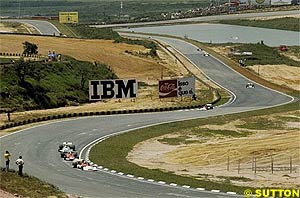 Later in the season, Fittipaldi made up for the disappointment of not having the honor of winning at his home track. By the Italian Grand Prix on September 9, 1972, Fittipaldi had clinched the 1972 World Championship, the youngest winner ever at 25 years old - a record Kimi Raikkonen and Fernando Alonso are targeting - and the first Brazilian to win the World Drivers' Championship. In years to come, Nelson Piquet and Ayrton Senna would follow in Emerson Fittipaldi's footsteps but he was the pioneer; by the 1972 season, Emerson Fittipaldi's older brother Wilson Fittipaldi and Carlos Pace rounded out the Brazilian contingent.
Later in the season, Fittipaldi made up for the disappointment of not having the honor of winning at his home track. By the Italian Grand Prix on September 9, 1972, Fittipaldi had clinched the 1972 World Championship, the youngest winner ever at 25 years old - a record Kimi Raikkonen and Fernando Alonso are targeting - and the first Brazilian to win the World Drivers' Championship. In years to come, Nelson Piquet and Ayrton Senna would follow in Emerson Fittipaldi's footsteps but he was the pioneer; by the 1972 season, Emerson Fittipaldi's older brother Wilson Fittipaldi and Carlos Pace rounded out the Brazilian contingent.
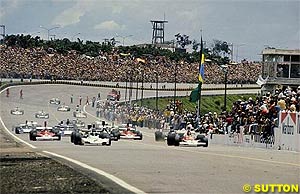 In 1978, the Brazilian Grand Prix was switched for one year from Interlagos on the outskirts of Sao Paulo to a new track at Jacarepagua, near Rio de Janeiro, a pre-cursor of things to come. Notwithstanding the change of venue, Ferrari's Reutemann won again in his Ferrari 312T2, leading flag to flag and Emerson Fittipaldi put in what was to be his best finish ever in the Fittipaldi family's Formula One car, second place at Rio.
In 1978, the Brazilian Grand Prix was switched for one year from Interlagos on the outskirts of Sao Paulo to a new track at Jacarepagua, near Rio de Janeiro, a pre-cursor of things to come. Notwithstanding the change of venue, Ferrari's Reutemann won again in his Ferrari 312T2, leading flag to flag and Emerson Fittipaldi put in what was to be his best finish ever in the Fittipaldi family's Formula One car, second place at Rio.
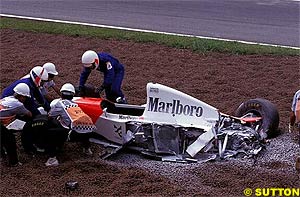 In 1993 Senna was set for his last Brazilian Grand Prix in the McLaren-Honda. On lap 1 of a race replete with retirements, Senna's McLaren teammate for most of the year, Michael Andretti, had a spectacular accident with Gerhard Berger's Ferrari, which put four cars out. Then Prost in the Williams-Renault led for 30 laps of the race before he skidded off during a sudden rainstorm. Damon Hill's Williams-Renault then took the lead for 11 laps, only to be succeeded by Senna ultimately taking the lead on lap 41, which he held for the balance of the wet/dry race. Once again Schumacher picked up third place in Brazil.
In 1993 Senna was set for his last Brazilian Grand Prix in the McLaren-Honda. On lap 1 of a race replete with retirements, Senna's McLaren teammate for most of the year, Michael Andretti, had a spectacular accident with Gerhard Berger's Ferrari, which put four cars out. Then Prost in the Williams-Renault led for 30 laps of the race before he skidded off during a sudden rainstorm. Damon Hill's Williams-Renault then took the lead for 11 laps, only to be succeeded by Senna ultimately taking the lead on lap 41, which he held for the balance of the wet/dry race. Once again Schumacher picked up third place in Brazil.
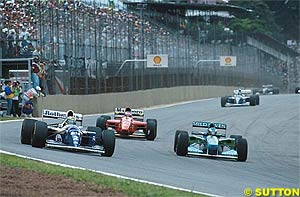 In 2001, Coulthard had his revenge, scoring his 10th Grand Prix win in a race that was full of the kind of intricacies which make Interlagos worth looking forward to each year. To begin with Barrichello had a fuel pump failure on a pre-race reconnaissance lap, forcing him to abandon his Ferrari out on the circuit and head back to take the spare car, which had been set up for Schumacher. When the cars took to the grid more disruption ensued when the Flying Finn flubbed his start, jerked forward a bit, then stalled. Amazingly, Coulthard and the others got by Hakkinen but it was a near thing, that scare doubtless helped Hakkinen confirm his decision to get away from all of this. Barrichello and Ralf Schumacher had also made bad starts, letting Michael Schumacher get out ahead, but it did not matter as the Safety Car came out to enable the corner workers to move Hakkinen's McLaren off the grid.
In 2001, Coulthard had his revenge, scoring his 10th Grand Prix win in a race that was full of the kind of intricacies which make Interlagos worth looking forward to each year. To begin with Barrichello had a fuel pump failure on a pre-race reconnaissance lap, forcing him to abandon his Ferrari out on the circuit and head back to take the spare car, which had been set up for Schumacher. When the cars took to the grid more disruption ensued when the Flying Finn flubbed his start, jerked forward a bit, then stalled. Amazingly, Coulthard and the others got by Hakkinen but it was a near thing, that scare doubtless helped Hakkinen confirm his decision to get away from all of this. Barrichello and Ralf Schumacher had also made bad starts, letting Michael Schumacher get out ahead, but it did not matter as the Safety Car came out to enable the corner workers to move Hakkinen's McLaren off the grid.
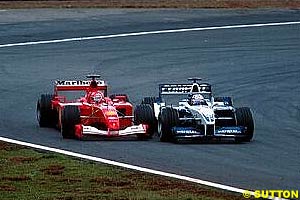 There was action elsewhere in these fast and furious opening laps of the 2002 race, with the Renaults of Jarno Trulli and Jenson Button showing the strength of their launch control by rocketing into third and fourth places behind the brothers Schumacher and local hero Barrichello in the year-old Ferrari 2001 in fifth place. By lap 4, Barrichello had gotten by both Renaults and was lying third behind Michael and Ralf. One lap later he got by Ralf, his third pass at the end of the front straight in just a few laps. By lap 13, Barrichello had passed his teammate in the F2002 car and taken the lead. Would this finally be the Brazilian's year to win his home race? In a word, no; that honor would go - again - to Michael Schumacher. After making this impressive charge through the field, on lap 17, Rubens slowed to a halt and parked it, suffering hydraulic failure and the Brazilians in the grandstands (where Barrichello used to watch as a boy) were no doubt saying to themselves in Portuguese, "maybe next year."
There was action elsewhere in these fast and furious opening laps of the 2002 race, with the Renaults of Jarno Trulli and Jenson Button showing the strength of their launch control by rocketing into third and fourth places behind the brothers Schumacher and local hero Barrichello in the year-old Ferrari 2001 in fifth place. By lap 4, Barrichello had gotten by both Renaults and was lying third behind Michael and Ralf. One lap later he got by Ralf, his third pass at the end of the front straight in just a few laps. By lap 13, Barrichello had passed his teammate in the F2002 car and taken the lead. Would this finally be the Brazilian's year to win his home race? In a word, no; that honor would go - again - to Michael Schumacher. After making this impressive charge through the field, on lap 17, Rubens slowed to a halt and parked it, suffering hydraulic failure and the Brazilians in the grandstands (where Barrichello used to watch as a boy) were no doubt saying to themselves in Portuguese, "maybe next year."
Please Contact Us for permission to republish this or any other material from Atlas F1.
|
Volume 9, Issue 14
Atlas F1 Exclusive
The French Connection: OPT Uncovered
Pizzonia: From Jungle to Jungle
Giancarlo Fisichella: Through the Visor
Articles
Karl Kling: An Appreciation
2003 Brazilian GP Preview
2003 Brazilian GP Preview
Between the Lakes
Brazilian GP Facts & Stats
Columns
The 700th GP Trivia Quiz
Bookworm Critique
On the Road
Elsewhere in Racing
The Weekly Grapevine
> Homepage |